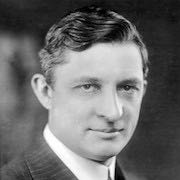Quick Facts
Biography
Willis Haviland Carrier (November 26, 1876 – October 7, 1950) was an American engineer, best known for inventing modern air conditioning. Carrier invented the first electrical air conditioning unit in 1902. In 1915, he founded Carrier Corporation, a company specializing in the manufacture and distribution of heating, ventilation, and air conditioning (HVAC) systems.
Early life and education
Willis Carrier was born on November 26, 1876, in Angola, New York, the son of Duane Williams Carrier (1836–1908) and Elizabeth R. Haviland (1845–1888).
He studied at Cornell University, graduating in 1901 with a BSE degree.
Career

In Buffalo, New York, on July 17, 1902, in response to an air quality problem experienced at the Sackett-Wilhelms Lithographing & Publishing Company of Brooklyn, Willis Carrier submitted drawings for what became recognized as the world's first modern air conditioning system. The 1902 installation marked the birth of air conditioning because of the addition of humidity control, which led to the recognition by authorities in the field that A/C must perform four basic functions:
- control temperature
- control humidity
- control air circulation and ventilation
- cleanse the air
After several more years of refinement and field testing, on January 2, 1906, Carrier was granted U.S. Patent 808,897 for an Apparatus for Treating Air, the world's first spray-type air conditioning equipment. It was designed to humidify or dehumidify air, heating water for the first function and cooling it for the second.
In 1906 Carrier discovered that "constant dew-point depression provided practically constant relative humidity," which later became known among air conditioning engineers as the "law of constant dew-point depression."On this discovery he based the design of an automatic control system, for which he filed a patent claim on May 17, 1907. U.S. Patent 1,085,971 was issued on February 3, 1914.
On December 3, 1911, Carrier presented what is perhaps the most significant document ever prepared on air conditioning – Rational Psychrometric Formulae – at the annual meeting of the American Society of Mechanical Engineers. It became known as the "Magna Carta of Psychrometrics."This document tied together the concepts of relative humidity, absolute humidity, and dew-point temperature, thus making it possible to design air-conditioning systems to precisely fit the requirements at hand.
With the onset of World War I in late 1914, the Buffalo Forge Company, where Carrier had been employed for 12 years, decided to confine its activities entirely to manufacturing. The result was that seven young engineers pooled together their life savings of $32,600 to form the Carrier Engineering Corporation in New York on June 26, 1915. The seven were Carrier, J. Irvine Lyle, Edward T. Murphy, L. Logan Lewis, Ernest T. Lyle, Frank Sanna, Alfred E. Stacey, Jr., and Edmund P. Heckel. The company eventually settled on Frelinghuysen Avenue in Newark, New Jersey.
Great Depression and afterwards
Despite the development of the centrifugal refrigeration machine and the commercial growth of air conditioning to cool buildings in the 1920s, the company ran into financial difficulties, as did many others, as a result of the Wall Street Crash in October 1929. In 1930, Carrier Engineering Corp. merged with Brunswick-Kroeschell Company and York Heating & Ventilating Corporation to form the Carrier Corporation, with Willis Carrier named Chairman of the Board.
The Great Depression slowed residential and commercial use of air conditioning. The company spread out over four cities in New Jersey and Pennsylvania until Carrier consolidated and moved his company to Syracuse, New York, in 1937. The company became one of the largest employers in central New York.
Willis Carrier's igloo in the 1939 New York World's Fair gave visitors a glimpse into the future of air conditioning, but before it became popular, World War II began. During the post-war economic boom of the 1950s, air conditioning began its tremendous growth in popularity. Today, air-conditioning and HVAC is a staple in many American homes.
Legacy
In 1930, Carrier started Toyo Carrier and Samsung Applications in Japan and Korea. South Korea is now the largest producer for air conditioning in the world. The Carrier Corporation pioneered the design and manufacture of refrigeration machines to cool large spaces. By increasing industrial production in the summer months, air conditioning revolutionized American life. The introduction of residential air conditioning in the 1920s helped start the great migration to the Sunbelt. The company became a subsidiary of United Technologies Corporation in 1980. The Carrier Corporation remains a world leader in commercial and residential HVAC and refrigeration.In 2007, the Carrier Corporation had sales of more than $15 billion and employed some 45,000 people.
Personal life
Carrier and all three of his wives, (Claire Seymour, d. 1912; Jennie Martin, d. 1939; Elizabeth Marsh Wise, d. 1964), are buried in Forest Lawn Cemetery in Buffalo, New York. Carrier fathered one child, Howard Carter Willis. He also fathered another two children from Jennie Martin. Vernon Gardner Carrier (1903- Apr 1985) and Earl Gardner Carrier (1905 - 23 Apr 1983.)
Carrier was a Presbyterian.
Awards and recognition
For his contributions to science and industry, Willis Carrier was awarded an engineering degree by Lehigh University in 1935 and an honorary Doctor of Letters degree by Alfred (NY) University in 1942; Carrier was awarded the Frank P. Brown Medal in 1942; and was inducted posthumously in the National Inventors Hall of Fame (1985) and the Buffalo Science Museum Hall of Fame (2008).


